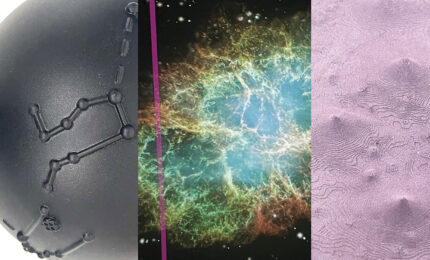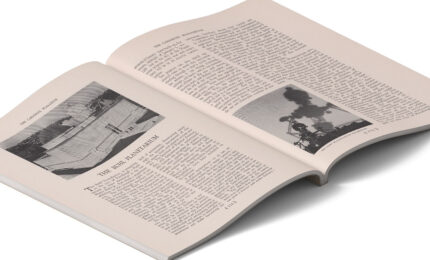The golden poison frog may be tiny but it’s nothing to mess with. One two-inch frog can kill 10 grown men. Gram for gram, the frog with the bold colors and striking patterns is one of the most toxic creatures on Earth, and it happens to be hopping around Carnegie Museum of Natural History.
There’s no need to duck for cover, even while wandering through a jungle environment that evokes the frog’s natural habitat, Chocó Rain Forest in Colombia, one of the wettest and most biodiverse places on the planet. Within the museum walls, the frogs don’t feed on the poisonous insects that make them so deadly in the wild. Their elaborate markings and bright hues (depending on their habitats they can be yellow, gold, copper, red, green, blue, or black) are deliberately flashy to warn—and ward off—potential predators, a tactic called “aposematic coloration.”
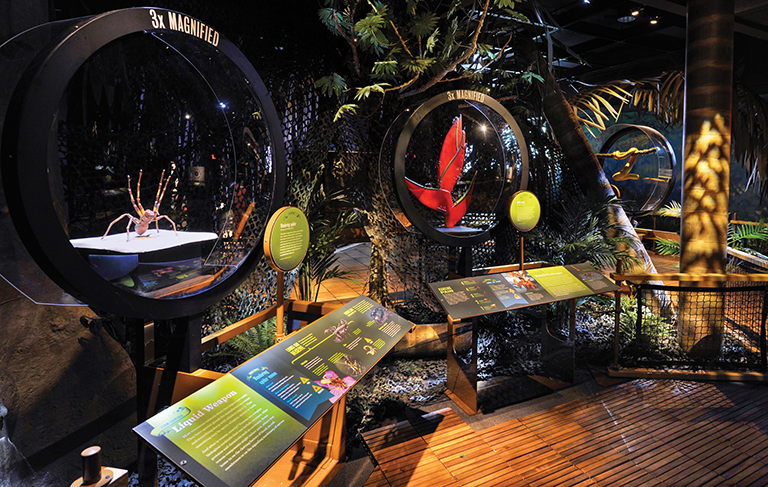
The re-created environment of the Chocó Rain Forest is full of life—and danger. Photo: ©AMNH/D. Finnin
“In the exhibit, the frogs are as colorful and harmless as crayons,” says Mark Siddall, curator of The Power of Poison, the sometimes-creepy, always-captivating world of poison created by the American Museum of Natural History in New York and on view at Carnegie Museum of Natural History through September 4.
In nature, medicine, and even literature, poison has long held us in its menacing thrall. Venomous snakes attack us. Poisonous plants cure us. Poison-plotted novels rivet us. “Our fascination with poisons is very similar to our fascination with magic,” Siddall says. “They’re mysterious things.”
It’s fitting, then, that The Power of Poison is both theatrical and immersive, and in a family-friendly twist conjures up some of fiction’s most notorious poison pushers.
Poison is Power
The three evil witches in Macbeth are shown stirring a bubbling cauldron of “Eye of newt, and toe of frog. Wool of bat, and tongue of dog… For a charm of powerful trouble, Like a hell-broth boil and bubble,” as Shakespeare wrote. While the witches look sinister, if you need a refresher on the Bard, they didn’t actually poison anyone in Macbeth. (And the tongue of dog isn’t a reference to an animal but the toxic plant houndstongue.)“They’re using the power of poison to draw forth the spirits that will tell the future of Macbeth,” says Siddall, a parasitologist, a scientist who studies parasites, their hosts, and relationships between them. His expertise is leeches, which are venomous.
In myth, and sometimes in life, access to poison imbues a character with the ultimate power. Ever wonder why Lewis Carroll’s wacky Mad Hatter spouted off all that nonsense in Alice in Wonderland? Hatmakers were known to have mood disorders, a trope that Carroll used in his childhood classic. But he likely didn’t know the science behind it. Hatmakers dating as far back as the 17th century, the exhibit reveals, would get mercury poisoning from the solution soaked into felt as it was being softened.
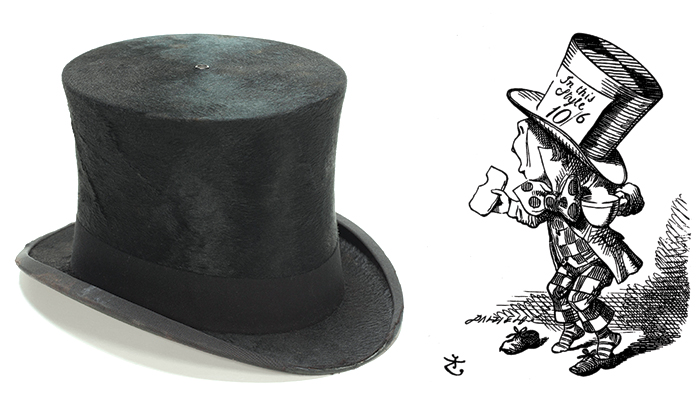
Hatters working in poorly ventilated factories breathed in toxic fumes, and prolonged exposure led to mercury poisoning with symptoms—such as trembling, memory loss, depression, irritability, and anxiety—that are still described as “mad hatter’s disease.” Photo: ©AMNH/C. Chesek
In other tall tales, poison makes a convenient murder weapon. And it’s much harder to get away with poisoning someone today than it was in centuries past. The turning point came in 1836, when chemist James Marsh developed a method for detecting arsenic. Before the Marsh Test, the odorless and colorless poison could be slipped into food and drink, undetected in the body. Arsenic was so effective that it was once dubbed the “inheritance powder.”
“As soon as the arsenic test became available, people got caught,” Siddall explains. “Poison appears in literature in a different way. You see people like Sherlock Holmes and Inspector Poirot detect poison. Science becomes the hero of the story.”
As for poisonous plot twists, Siddall rates Agatha Christie as his favorite, for being both scientifically accurate and clever. His choice Christie caper is found in the book The Mysterious Affair at Styles, where character Emily Inglethorp dies of strychnine poisoning.
“The poisoning is really ingenious,” says Siddall. “The strychnine in the glass is crystallized and transparent,” enabling the murderer to pour untainted liquid into two glasses. “The victim has no idea she is taking her last sip on earth.”
“Our fascination with poisons is very similar to our fascination with magic. They’re mysterious things.” – Mark Siddall, curator of The Power of Poison
When it comes to true-crime mysteries plucked from history, consider Cleopatra, the queen of Egypt, whose cause of death has fascinated people for centuries. One theory holds that she was poisoned from the bite of an asp, a poisonous snake.
No way, says Siddall. “The European asp is not nearly venomous enough. No number of asps could bite you all at once and kill you.” It turns out that the much more venomous Egyptian cobra is a more likely candidate.
What can kill can cure
In The Power of Poison, poisonous plants are brought to life in an “enchanted” book of ancient botanical knowledge in which hand-drawn illustrations respond to touch. As Belladonna and Conium (otherwise known as hemlock) “bloom,” drawings give way to animations, showing, for example, why rhododendron is known in some regions as “goat-bane” and animals can die from munching its leaves.
The interactive book reveals both sides of the story: that plants can be as beneficial as they are deadly. A compound found in the bark of a poison yew tree, for example, is used to create Taxol, a chemotherapy drug used to treat breast cancer, and the venom of pit vipers (also found in the Chocó Rain Forest) has led to blood pressure drugs. And there’s more hope on the horizon: the saliva of vampire bats contains an anti-clotting agent coyly called draculin, which may protect against strokes, and toxins from the mauve stinger jellyfish may be of use in treating Alzheimer’s disease.
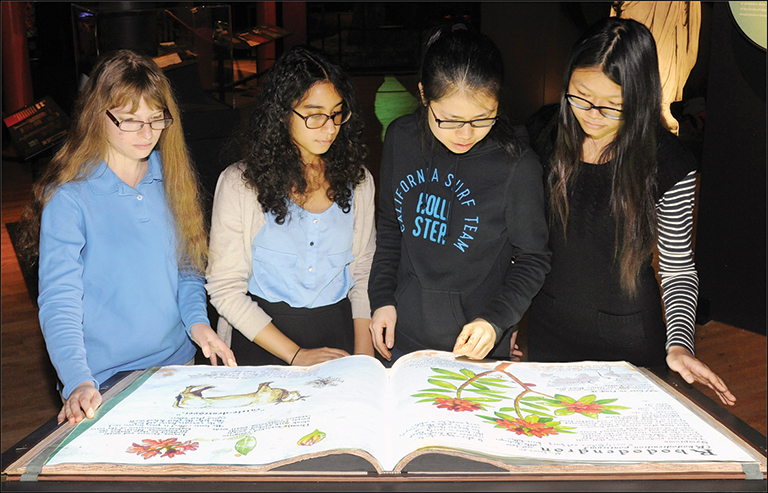
In this “enchanted” book, moving illustrations “magically” appear with each turn of the page.
Other substances have unintended toxic side effects. “Chocolate is poison for dogs,” says John Wenzel, director of Powdermill Nature Reserve, the environmental research center of Carnegie Museum of Natural History, and an early advisor on The Power of Poison. “It was never intended to be that way. It’s just a coincidence.”
In contrast, the golden poison frog evolved into deadly creatures to keep predators away.
Named because indigenous people would rub their arrows against the animal’s skin, the frog gets its poison power from its insect diet. The toxins that the frogs ingest are not broken down and are deposited into their skin membrane.
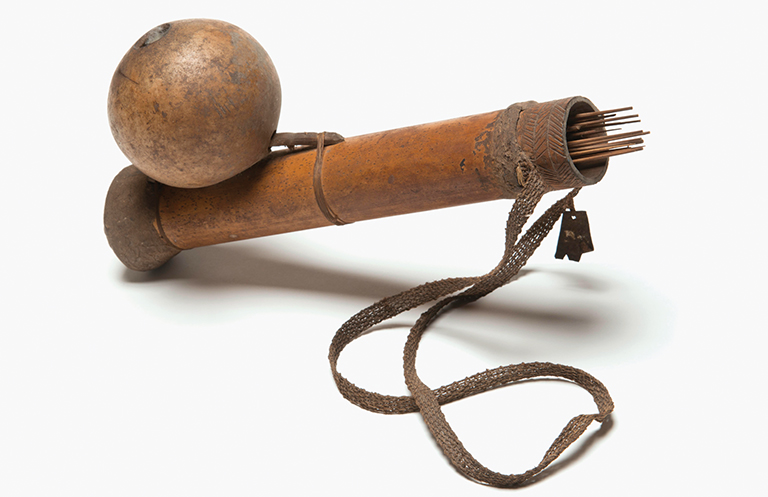
Darts like these would have been coated by hunters with a powerful plant-based toxin known as curare. Photo: ©AMNH/C. Chesek
But scientists aren’t sure exactly what the frogs eat that give them their poisonous powers. “Soft winged flower beetles are suspected,” Siddall says. “But it’s not been proven. This is not easy work to do.”
Take them out of their wild habitat and feed them something nontoxic, like mealworms and crickets, and the frogs could be household pets. Ask Wenzel. He’s had pet poison dart frogs for the last decade, and the scientist has lived to tell about it.
“They are beautiful little gems, easy to care for,” Wenzel says. “In a planted terrarium, they bring a piece of the emerald forest into your house. And they will sing, too.”
Poison: It’s everywhere
The role of evolution in making certain species more poisonous is also explored in the exhibit. Take the rattlesnake, avowed enemy of humans because of its venomous bite. Its poisonous bite is actually a side effect of the “evolutionary arms race” with opossums.
“Opossums eat snakes. Rattlesnakes defend themselves with even stronger toxins,” Siddall explains. “Opossums become more resistant to rattlesnakes. The potency of that venom is intended to protect against opossums. We get hit with it and die. Everyone thinks powerful venoms are offensive. But more often than not, they’re defensive.”
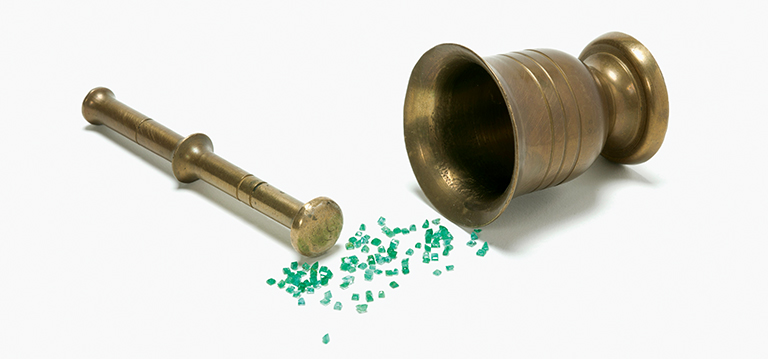
Emeralds and garnets were said to protect against snake venom and other poisons as far back as the ancient Egyptians. Photo: ©AMNH/C. Chesek
Another toxic truth: Poison is everywhere. “Salt is poisonous if you have too much of it,” Siddall says. “It will shut down your nervous system.” Some over-the-counter pain medications can cause liver damage if the dosage is too high. And what about all those poisonous household cleaners and chemicals, a constant worry for new parents? Enter Mr. Yuk, a special Pittsburgh addition to the exhibit. That’s because Dr. Richard Moriarty, a retired Children’s Hospital of Pittsburgh pediatrician, designed the iconic warning sticker while he strengthened the role of poison centers in the United States.
It was 1972, and Moriarty was fielding calls from panicked parents whose toddlers had just gulped down drain cleaner or cleanser. In one case, a child died because the parents got in a car accident on the way to the hospital. The sad irony is that the poison would never have killed the child.
Moriarty helped stop those mad-dash hospital runs by establishing centralized and well-staffed poison centers. “Running a good poison center is expensive,” says Moriarty, who today is a Carnegie Museum of Natural History board member. “It takes knowledgeable people available seven days a week, 24 hours a day. Some cities might have a need for eight poison centers.”
He wanted a new symbol for the new model of poison centers—one that would deter toddlers from grabbing for the chemicals in their house. The existing warning symbol—a skull and crossbones—didn’t deter kids, especially those in Pittsburgh, because it looked like the Jolly Roger emblem of the Pittsburgh Pirates. So Moriarty and a graphic artist did a focus group with preschoolers, showing them a sick face, dead face, and yelling face. The toddlers cringed most at the sick face. They also tested colors, and fluorescent green was their least favorite.
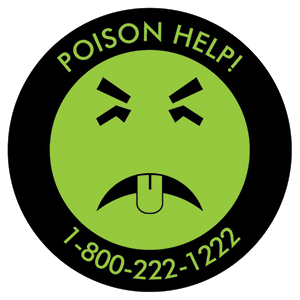
“That looks yucky,” one kid said. “Okay, we have a name,” Moriarty recalls saying. Mr. Yuk has lived on long after Moriarty’s retirement in 1989. In fact, last year a neighbor brought him a New York Times crossword puzzle with the clue: a five-letter word for the iconic poison sticker. “It has a life of its own,” says Moriarty. “It amazes me.”
When people find out he created Mr. Yuk, they sometimes thank him for saving their child’s life. Some people even call him Dr. Yuk.
“I’ll take it,” he says. “No offense taken.” Wenzel believes the warnings that parents give their children about bee stings and the toxins in household chemicals are one of the reasons humans have such an enduring fascination with poison—and why The Power of Poison exhibit resonates so deeply with the public.
“Our parents tell us, ‘Don’t put that in your mouth.’ You learn the world is filled with dangerous things,” Wenzel says. “That ends up giving poison special status.”
The Power of Poison is sponsored locally by the PA Distance Learning Charter School.

